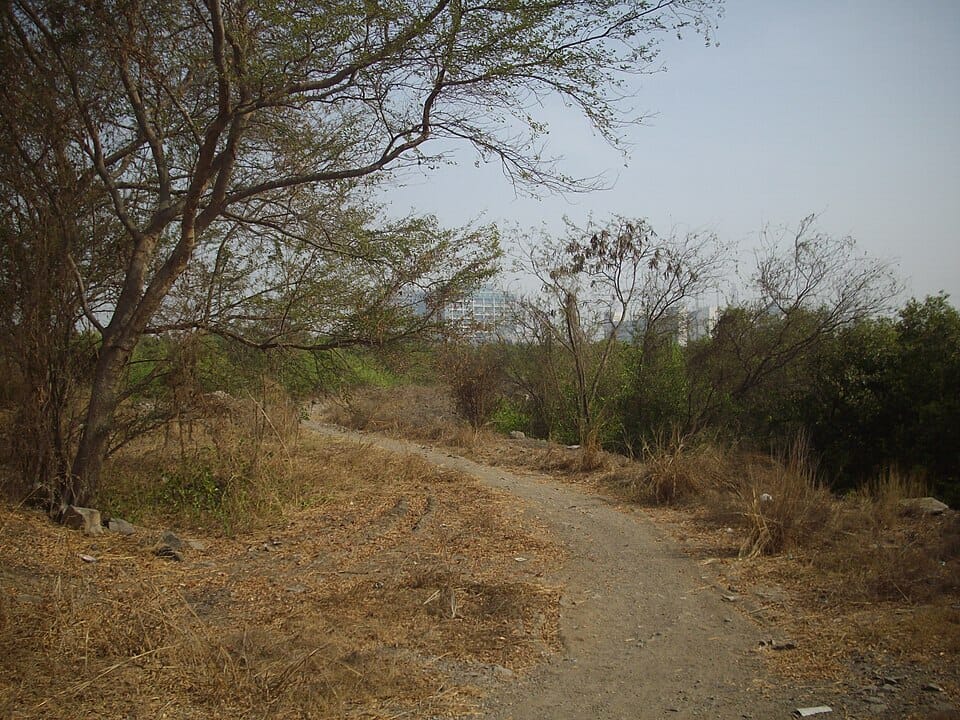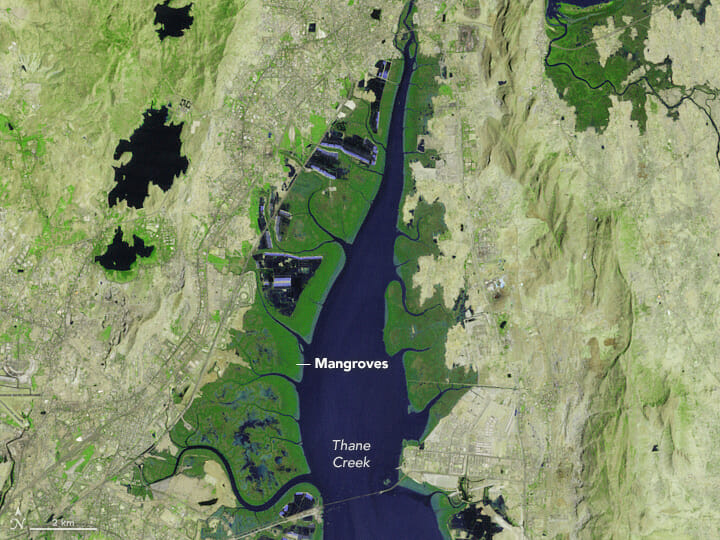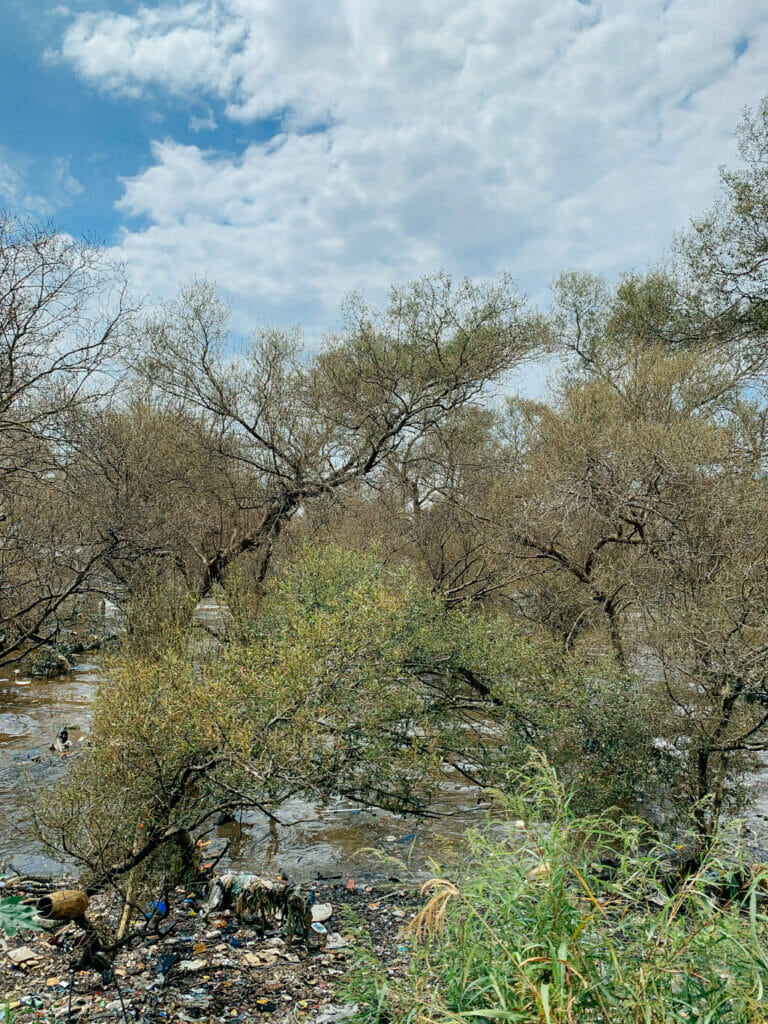A mangrove is a shrub that grows along coasts and has roots that are usually found underwater. Mangroves store ‘more carbon per unit area than any other ecosystem on Earth’, and aid in the fight against coral bleaching. They act as natural barriers against storms and rising seas, saving ‘more than $65 billion worth of property damage each year’, according to conservation.org. They thrive in subtropical nations since they are adaptive, and are the best option for mitigating the effects of climate change, be it sea-level rise or the frequency of natural disasters such as cyclones and storm surges.
However, according to The Global Mangrove Alliance’s (GMA) annual study titled The State of the World’s Mangroves 2022, a total of “5,245 square kilometres of mangrove forest has been destroyed since 1996” globally. This loss is the result of direct human activities such as land removal and conversion, soil erosion, flooding and storms.
Owing to their capacity to store carbon, the counter effect of mangrove loss is severe too. It should be remembered, that for every 1% increase in mangrove loss, 200 million tonnes of carbon get released into the air and are not trapped by mangroves.
In Maharashtra, ongoing public and private efforts to protect mangroves have been exemplary. It is the only state with a dedicated mangrove protection cell. Over the last decade, however, annual losses have been reduced to 0.04 percent, whereas river mouths and deltas have seen significant improvements.
State of mangroves in Mumbai
India has about half of South Asia’s total mangrove cover, wherein West Bengal is home to the world’s largest mangrove forest. According to the Forest Survey report 2021, the nation’s 4,992 square kilometres of mangroves have only grown by 17 square kilometres since 2019. According to the GMA’s 2022 study, between 2010 and 2020, 600 sq km of mangroves were destroyed, and more than 62% of that loss was attributable to direct human influences.
Spread over several regions of Maharashtra, mangroves grow in Mumbai City, Mumbai Suburban, Palghar, Thane, Raigad, Ratnagiri and Sindhudurg, of which 19,500 hectares have been declared as reserve forest area. Mumbai City’s mangrove cover is spread over 40 square kilometres.
The India State of Forest Report released by the Forest Survey of India has stated that the mangroves in the city have suffered the highest damage with a loss of 1.08 square kilometres of mangroves. Multiple instances of mangrove destruction for construction activities further deteriorating the mangrove cover. Be it the dying mangroves in Kanjurmarg or the environmentalist call for saving mangroves at Palm Beach Road being destroyed, they are being systematically cleared. The need to protect them has become even more urgent.

Read more: In the destruction of wetlands, is CIDCO above the law?
Mangrove Protection Coalition-COP27 and India’s commitments
The COP27 has concluded, and the COP15 on Conservation of Biodiversity (CBD) began a few days ago. We can only hope to fulfil the promise of the Paris Agreement by acting swiftly to stop and reverse the loss of nature this decade and by stepping up our efforts to rapidly decarbonize our economies.
To scale the awareness and actions in the case of Mangrove forests, India became a signatory to the Mangrove Alliance for Climate ( MAC) coalition formed at COP. However, because the international alliance for mangroves is voluntary, there aren’t any mechanisms in place to hold members accountable. The parties will instead set their timelines and obligations for planting and rehabilitating mangroves.
And as the world brought its focus to the COP27 discussions, Kolis continued to push for their participation in roundtable discussions to better understand the major difficulties they face and how to address them as they continue to campaign for the recognition of their indigenous knowledge and rights.
Possible impact on Mumbai’s mangroves
Amidst all this, the Brihanmumbai Municipal Corporation (BMC) published The Mumbai Climate Action Plan (MCAP) in March 2022, as the Indian government prepares to update more of its climate commitments from those made under the 2015 Paris Agreement.
As these solutions are not enforceable by law , it effectively means that “climate action” will be left to the well-intentioned efforts of bureaucrats. The launch of such a plan has further prompted scientists and climate activists in the area to examine the policies and promises, which brings the support for the Aarey forest and the Mangroves in the different parts of Mumbai as organisations like Fridays for Future Mumbai and numerous alliances continue to bring forth voices of the communities who have dedicated their livelihoods on them for generations.
Several ecologists have also pointed out the government’s misleading numbers about the tree cover coming from plantations outside the legally protected forest area, causing the Union Ministry of Environment, Forest and Climate Control (MOEFCC) to launch the subsequent investigation.
While Mumbai looks at significant infrastructure projects, these not only become causes for the lost ecology and exacerbate weather issues, but also rip away livelihoods and communities that have lived there for generations. The recent National High Speed Rail Corporation (NHSRCL) approval from the Bombay High Court will wipe out 20 thousand mangroves for the Mumbai-Ahmedabad bullet train project.
What can be done at the local level?
Historically, “relentless building” is often seen as a solution to old problems in Mumbai. The coastal road, an ongoing effort to create the first 9.8km and fill in a portion of the city’s shoreline, is best understood as an old mistake applied to a new issue.

The direct impacts of climate change due to the loss of these natural features – the reducing wetlands, open spaces and claiming more ocean footprint for a low lying coastal town is an antithesis in itself.
Together, we need to fight against concretisation, through on-ground and online petitions with several local groups already working for the same.
Read more: Activists win in the fight to save Panje
Supporting local knowledge and ideas, supporting indeginous groups, using less plastic and preventing it from entering these habitats can do a small part in restoring forests.
Take part in cleanups, educational workshops on these shrubs, participate in plantations and drives to take care of our mangroves. And if you don’t have the time, do your part in advocating for our collective future by their restoration.

Mumbai across scales has tirelessly demonstrated the value of interdisciplinary bases that combine traditional knowledge, scientific information, and the intimate, practical knowledge of a community’s environment, but now the policies need to take that heed. We as citizens hold the power to push for this change, by submitting reviews of these policies, educating one another about the implications, or helping NGOs and coalitions working for the betterment of these implications.
Climate change is bound to alter society and heighten our inequalities, it rests on us on whether we choose to rise together or sink, quite literally.